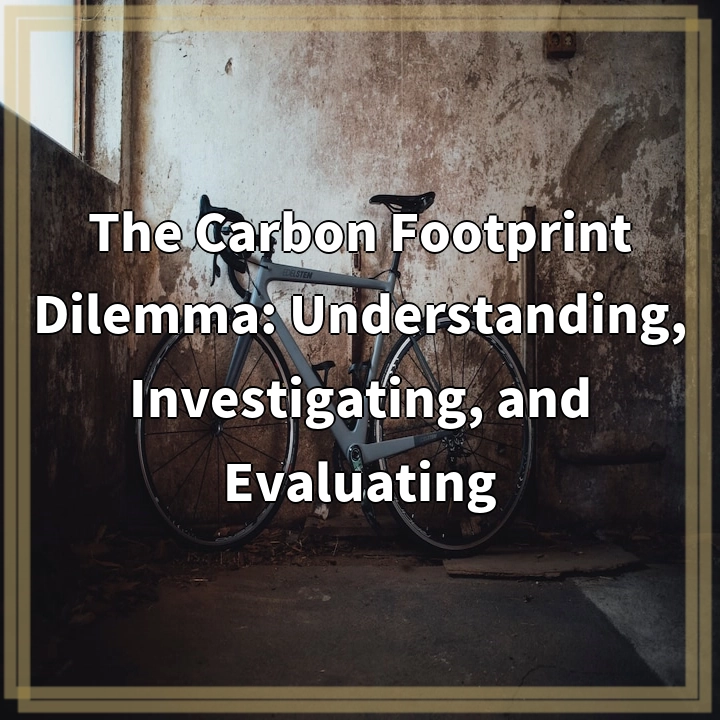
What is the Carbon Footprint Dilemma?
The Carbon Footprint Dilemma is a complex issue that refers to the total amount of greenhouse gas emissions produced by human activities, measured in units of carbon dioxide (CO2) equivalent. It is a metric used to assess the impact of individuals, organizations, or products on climate change. The carbon footprint encompasses various emissions sources, including energy consumption, transportation, waste management, and industrial processes.
Real-World Problems Associated with the Carbon Footprint
1. Climate Change:
The primary concern with carbon footprints is their contribution to anthropogenic climate change. Excessive greenhouse gas emissions, particularly CO2, lead to the intensification of the greenhouse effect, resulting in rising global temperatures, extreme weather events, and disrupted ecosystems. Decelerating climate change requires significant reductions in carbon footprints on a global scale.
2. Environmental Degradation:
The carbon footprint is closely linked to environmental degradation. From deforestation for agriculture or timber to the extraction and burning of fossil fuels, various human activities contribute to the accumulation of carbon dioxide in the atmosphere. These practices not only release greenhouse gases but often lead to habitat destruction, loss of biodiversity, and negative impacts on air and water quality.
3. Resource Depletion:
High carbon footprints are often associated with unsustainable consumption patterns. The production and consumption of goods and services require significant amounts of energy and resources, leading to the depletion of finite resources such as fossil fuels, water, and minerals. Minimizing carbon footprints can help promote more sustainable resource management, ensuring the availability of resources for future generations.
4. Socioeconomic Inequities:
The carbon footprint dilemma also highlights socioeconomic inequities. Low-income communities and individuals often have limited access to clean and renewable energy sources, which intensifies their reliance on fossil fuels and increases their carbon footprints. The burden of adapting to climate change, such as dealing with the impacts of extreme weather events or rising sea levels, is disproportionately borne by marginalized communities.
5. Public Health Impacts:
The consequences of carbon footprints extend to public health. The burning of fossil fuels emits harmful pollutants that contribute to air pollution, which can lead to respiratory and cardiovascular diseases. Additionally, climate change, exacerbated by high carbon footprints, can result in the spread of infectious diseases, food and water shortages, and mental health issues among affected communities.

Potential Solutions to Address the Carbon Footprint Dilemma
Finding effective solutions to reduce carbon footprints is essential for mitigating climate change and promoting sustainable practices. Here are some potential avenues to address the carbon footprint dilemma:
1. Transition to Renewable Energy:
One of the most significant steps towards reducing carbon footprints is transitioning from fossil fuel-based energy sources to renewable alternatives like solar, wind, and geothermal energy. Investing in renewable energy infrastructure and promoting their widespread adoption can significantly decarbonize energy production.
2. Energy Efficiency Measures:
Improving energy efficiency across sectors is crucial for reducing carbon footprints. Implementing energy-efficient technologies, promoting conservation practices, optimizing transportation systems, and adopting sustainable building designs can all contribute to significant energy savings and emissions reductions.
3. Sustainable Transportation:
Promoting sustainable transportation options, such as public transit, cycling, and electric vehicles, can help lower carbon footprints associated with transportation. Investing in public transportation infrastructure, promoting active transportation, and transitioning to electric vehicles can contribute to significant emissions reductions.
4. Adopting Circular Economy Practices:
Transitioning towards a circular economy, where resources are reused, recycled, and waste generation is minimized, can help reduce carbon footprints. This involves promoting sustainable production and consumption patterns, minimizing waste generation, and implementing recycling and composting programs.
5. Reforestation and Forest Conservation:
Protecting and restoring forests plays a crucial role in reducing carbon footprints. Forests act as carbon sinks, absorbing CO2 from the atmosphere. Promoting reforestation efforts, ending deforestation practices, and implementing sustainable forestry practices can help sequester carbon and mitigate climate change.
6. Individual Actions and Consumer Choices:
Individuals can contribute to reducing carbon footprints through their daily actions and consumer choices. This includes energy conservation, reducing waste, eating a plant-based diet, supporting sustainable businesses, and advocating for climate-friendly policies.
Addressing the carbon footprint dilemma requires a collective effort from governments, businesses, communities, and individuals. By implementing these solutions and prioritizing sustainability, we can work towards a more resilient and environmentally conscious future.















